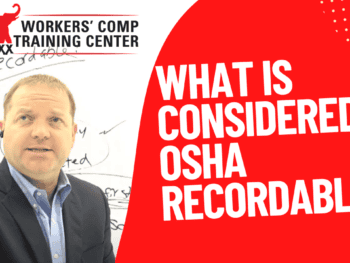An Interview with Rebecca Shafer about how to resolve problems with TPAs and Insurance Companies
Rebecca Shafer is a leading industry expert on workers compensation issues and President of Amaxx Risk Solutions. She developed workers compensation cost containment programs for Marsh and Aon to help their clients implement cost reduction strategies. Her clients typically decrease their costs between 20-50% in incurred losses.
- Describe a real example of a dispute between an employer and its TPA/insurer involving a claim or group of claims. Was it resolved and how?
Situation: A large theme park located in Florida thought the insurer was:
- a) overcharging for nurse case management,
- b) using nurse case management when it wasn’t necessary, (WCxKit)
- c) using nurse case management service as a profit center at the expense of the insured, and
- d) having nurses do “adjuster level” work.
The dissatisfaction had grown to such proportions the theme park was threatening to move the business.
Resolution: A team of 7 including an MD and 6 senior claims experts reviewed all open files and some closed files in the Florida office. The team reviewed special handling instructions, the carrier’s best practices, the carrier’s Litigation Guidelines to establish performance expectations.
The team scored the files: 87% of claims the files were handled according to account specifications, carrier best practices and industry best practices. The MD determined that nurse case management was used effectively and benefited the claim outcome in most cases. Also, 95% of employees were receiving excellent quality medical care.
One problem was many employees were going to non-network providers thus adding to the cost of medical care. Employees had to wait 4 hours at the in-network clinic several miles farther away, so they went to a non-network clinic only one block away where they were treated immediately.
We set up van service to the farther network clinic and corrected the 4-hour wait problem. We also added the closer clinic to the network and established a relationship with that clinic.
Two-hour training sessions were held for all supervisors and managers explaining what to do when an employee is injured, how to get to providers, quality of care standards, etc. We set up the system so the account receive monthly “penetration reports” to monitor improvement.
A quick benchmark report showed the Cost Per Employee (FTE) was one-half the national average. This indicated, statistically, the carrier was performing quite well and the costs were not being negatively impacted, although improvements were made. THIS should have been done before the problem was out of hand, and the broker incurred a huge fee to correct the problem. Had it been done months earlier, they would have known that the company was HALF the industry average — so really, how bad could “the problem” really have been?
I met with the Claims Manager at the initial stages of the project to get her perspective of why the client was so upset, and she told me she had never spoken with the client. I then spoke with the client and asked her what she had told the Claims Manager about the problem. She said she had never spoken with the Claim Manager. I asked the Client why, given that she was so upset with the claim handling, she had never spoken with the Claim Manager and she said “Well, she should call me; I shouldn’t have to call her.”
Although the real problem was lack of communication, nurse case management was perceived as a problem and festered for months getting greatly exaggerated. At the end of the process, we had all adjusters and the Claim Manager visit the theme park to view operations and transitional duty options. We also had the insured visit the claims operation and medical cost containment facility to understand better the process from the inside.
Result: Losses down 43%. Carrier kept account.
- Could the disputes noted have been avoided? If so, how?
Yes, these disputes are almost always avoidable. Many are due to lack of communication.
If the broker had benchmarked the employer losses, they would have known that the Cost per Claim and Cost per FTE (full-time employee) for this employer was half the national average in case #1. In Case #2, the costs were twice the national. This puts the situation in perspective – is there really a problem or is it being blown out of proportion from frustration.
Hold monthly roundtable meetings (conference calls) to insure open communication and discussion of “issues” in a constructive way. Initially, I start with weekly calls. Regular calls at a pre-established time let the client know there is a place to discuss issues.
- Please summarize.
Often, complaints are not related to a specific claim such as “the reserve on this claim is too high,” but are vague, such as “the claims are poorly handled.” The insured has a feeling things aren’t right, and they are often correct, but they can’t put pinpoint exactly what is wrong until something big happens like a claim is settled that they know is bogus. (WCxKit)
Often their “gut” feeling is accurate, but they feel silly or trivial speaking to their broker until they have a very clear example, so they wait until things get worse. This is where those operational benchmarks are helpful: it helps employers learn what other companies are doing operationally to control costs. It educates them to “possibilities.”
Author Rebecca Shafer, JD, President of Amaxx Risks Solutions, Inc. is a national expert in the field of workers compensation. She is a writer, speaker and website publisher. Her expertise is working with employers to reduce workers compensation costs, and her clients include airlines, healthcare, printing/publishing, pharmaceuticals, retail, hospitality and manufacturing. Contact: RShafer@ReduceYourWorkersComp.com
WORK COMP CALCULATOR: http://www.LowerWC.com/calculator.php
MODIFIED DUTY CALCULATOR: http://www.LowerWC.com/transitional-duty-cost-calculator.php
WC GROUP: http://www.linkedin.com/groups?homeNewMember=&gid=1922050/
SUBSCRIBE: Workers Comp Resource Center Newsletter
Do not use this information without independent verification. All state laws vary. You should consult with your insurance broker or agent about workers comp issues.
©2010 Amaxx Risk Solutions, Inc. All rights reserved under International Copyright Law. If you would like permission to reprint this material, contact Info@ReduceYourWorkersComp.com
















